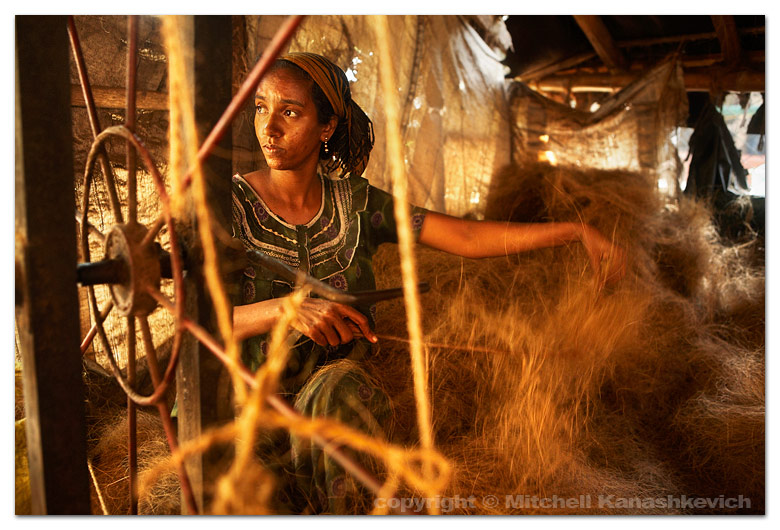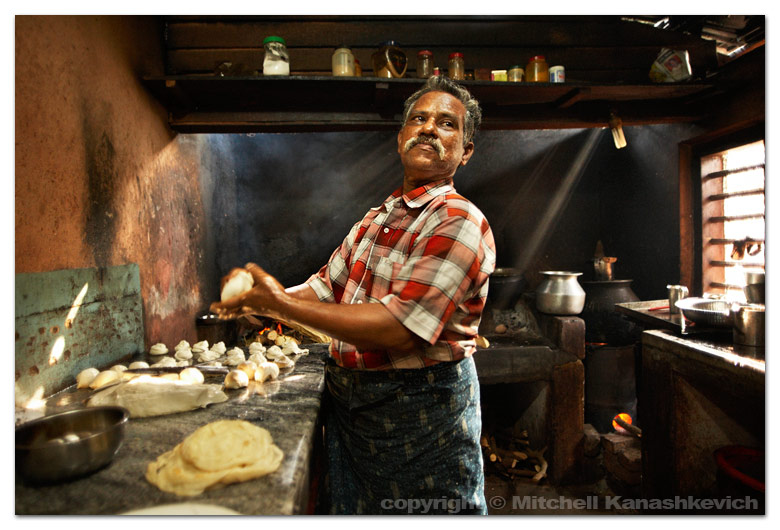Going South or "Chocolate, school-pen, hello-ten-rupees!"
 Whenever tourism hits a place in a developing country it seems to create the "chocolate, school-pen and hello-ten-rupees" (or whatever other currency) phenomenon. A mushrooming of expensive restaurants with rubbish food follows and then all the prices for regular services skyrocket. I really dislike the way tourism from the 'rich' world shapes the 'poor' world. The sort of interaction between the two breeds cynicism, and for a photographer of people cynicism is a very dangerous thing. What will your photograph say if your subject sees you as nothing more than a moneybag and you see the subject as someone who will do anything to get a piece of that money? I would never want to take photos that way.
Whenever tourism hits a place in a developing country it seems to create the "chocolate, school-pen and hello-ten-rupees" (or whatever other currency) phenomenon. A mushrooming of expensive restaurants with rubbish food follows and then all the prices for regular services skyrocket. I really dislike the way tourism from the 'rich' world shapes the 'poor' world. The sort of interaction between the two breeds cynicism, and for a photographer of people cynicism is a very dangerous thing. What will your photograph say if your subject sees you as nothing more than a moneybag and you see the subject as someone who will do anything to get a piece of that money? I would never want to take photos that way.
 Is tourism bad? I've got no answer to that. As far as what I’ve seen, the negative impact often outweighs any positives. Of course it ultimately depends on what your priorities are. If you'd like to have everything at the snap of your fingers because you have the money and you don't mind that your relationships with people in these so called "third world" countries are nothing more than transactions, then tourism has worked out well for you. If, however you want to genuinely experience a culture and not be confronted with a price-tag for a smile or a hello, well then you're really outta luck. Since I belong to the latter category I avoid tourist "hot-spots" like I'd avoid the plague. But it's impossible to avoid them completely, some are on your way, others lure you in with something you simply can't resist and then there are times when you think it won't be as bad as people say. My next couple of stops after Thrissur fell under a few of those categories. Cochin lured me in with the images I had seen of the Chinese fishing nets and tales about colorful colonial architecture. Allepey, dubbed the Venice of India was on the way, and the Venice thing sounded tempting.
Is tourism bad? I've got no answer to that. As far as what I’ve seen, the negative impact often outweighs any positives. Of course it ultimately depends on what your priorities are. If you'd like to have everything at the snap of your fingers because you have the money and you don't mind that your relationships with people in these so called "third world" countries are nothing more than transactions, then tourism has worked out well for you. If, however you want to genuinely experience a culture and not be confronted with a price-tag for a smile or a hello, well then you're really outta luck. Since I belong to the latter category I avoid tourist "hot-spots" like I'd avoid the plague. But it's impossible to avoid them completely, some are on your way, others lure you in with something you simply can't resist and then there are times when you think it won't be as bad as people say. My next couple of stops after Thrissur fell under a few of those categories. Cochin lured me in with the images I had seen of the Chinese fishing nets and tales about colorful colonial architecture. Allepey, dubbed the Venice of India was on the way, and the Venice thing sounded tempting.
 I probably romanticized Cochin like no other place in India and when you do that you set your self up for disappointment. But Cochin didn't really disappoint me as a visitor, it was in many ways what I had imagined, however this city did tease me and didn't give me what I wanted, photographically speaking. I only saw hints of what could have been, had the day of the week been right, had there not been a crowd of tourists photographing the same person I wanted to photograph, had the fishermen at the Chinese nets not tried to get money out of me for "allowing" me to see how they work. There are countless stories in that city and I'm sure that many are very photogenic, but having only a limited amount of time and only one life, you think; is there another place I'd rather be? And there are, quite many, so we moved on.
I probably romanticized Cochin like no other place in India and when you do that you set your self up for disappointment. But Cochin didn't really disappoint me as a visitor, it was in many ways what I had imagined, however this city did tease me and didn't give me what I wanted, photographically speaking. I only saw hints of what could have been, had the day of the week been right, had there not been a crowd of tourists photographing the same person I wanted to photograph, had the fishermen at the Chinese nets not tried to get money out of me for "allowing" me to see how they work. There are countless stories in that city and I'm sure that many are very photogenic, but having only a limited amount of time and only one life, you think; is there another place I'd rather be? And there are, quite many, so we moved on.
Allepey was our next stop. I heard that it was not that special from a few people I'd come across, but who could resist at least having a glance at "Venice of India". Having never actually been to Venice I don't know how Allepey measures up, but it was indeed not that special, as far as personal impressions go. The town did give me an introduction to the backwaters of Kerala that I had seen in so many photos and, in the surrounding areas I was given a dose of that real tourist-equals-moneybag welcome.
 Paying three times the price for a supposedly traditional, yet crappy, small fish dishes at an eatery on an isolated island was inevitable. The next boat back was two hours away and the eatery was the only thing on the island. Getting knocked out by half a liter of "Tori" (a palm drink with an alcoholic effect) on the same island should have been expected by someone who can't remember when he had his last drink. The tori induced nap did prove to be practical, as the tiny portion of food left a lot of time to kill. The next day at nearby Marari beach we were briefly stalked by very cute little girls who demanded pens for a made-up school exam and after hearing a negative response kept nagging my wife,” Please open the bag! Please let me see what is inside your bag!" Oh, Kerala, God's Own Country!
Paying three times the price for a supposedly traditional, yet crappy, small fish dishes at an eatery on an isolated island was inevitable. The next boat back was two hours away and the eatery was the only thing on the island. Getting knocked out by half a liter of "Tori" (a palm drink with an alcoholic effect) on the same island should have been expected by someone who can't remember when he had his last drink. The tori induced nap did prove to be practical, as the tiny portion of food left a lot of time to kill. The next day at nearby Marari beach we were briefly stalked by very cute little girls who demanded pens for a made-up school exam and after hearing a negative response kept nagging my wife,” Please open the bag! Please let me see what is inside your bag!" Oh, Kerala, God's Own Country!
But just as our levels of cynicism peaked, there was an unexpected stop at what's at least pretty close to being a magical little village by the lake - Alumkadavu. The first house boat (those things that tourists pay big bucks to rent) was built in Alamkadavu, and unless I met an imposter, then I accidentally stumbled upon the gentleman who was in charge of making that very first boat. These houseboats are impressive and I really mean it when I say it. They range from small and basic to close to 30 meters long and luxurious. I'd really love one of these, if I have good enough fortune to afford it, which seems like I won't anytime too soon, since the price quoted to me was $110,000 Australian Dollars for a fully furnished, air conditioned boat. Still, one can dream.
 Alumkadavu is a tiny place, but it's famous for the 'vallom' (traditional boat) making at the same place where the first houseboat was built. It's also famous for a mini coir industry. Coir is the fiber of a dry coconut shell and it’s used for all sorts of things – insulation, mattresses and ropes.
Alumkadavu is a tiny place, but it's famous for the 'vallom' (traditional boat) making at the same place where the first houseboat was built. It's also famous for a mini coir industry. Coir is the fiber of a dry coconut shell and it’s used for all sorts of things – insulation, mattresses and ropes.
This brings me to the photos.
- The first image is of a small passenger boat. There are many of these boats navigating the Ashtamudi Lake and the surrounding canals.
- Men fixing a house boat. Apparently the boats can go eight years without needing any real maintenance. I was shown one boat which was 40 years old and in need of only some simple work.
- The view from our room in Alumkadavu - a house boat ready for departure, after spending the night by the nearby dock.
- A woman weaving a rope from coir.
- In Alumkadavu we had our food at a tiny local eatery and while we waited, I snapped a few frames of this man making parothas (a kind of pancake made up of thin layers of flour). While I photographed, the man kept saying "Good, good. One parotha. Thank you! Thank you!" I think that was about all he knew in English and he seemed to have lots of fun repeating it. Quirky character. Shot with a Sigma 20mm f1.8. I am loving this lens more and more. I hesitated getting it a couple of years back. Now I realize that I have only really used my Canon 24-70 f2.8 and the Sigma. Awesome lens! Not without imperfections, especially on a full frame camera, but at f1.8 and a relatively wide angle I can shoot stuff like this, which would be impossible otherwise.